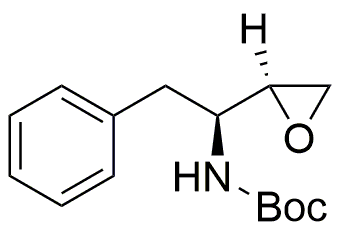(2S,3S)-3-(tert-Butoxycarbonylamino)-1,2-epoxy-4-phenylbutane is widely utilized in research focused on:
- Synthetic Organic Chemistry: This compound serves as a versatile intermediate in the synthesis of complex organic molecules, enabling chemists to create a variety of derivatives for further study.
- Pharmaceutical Development: It is employed in the design of new drug candidates, particularly in the development of compounds with potential therapeutic benefits in treating various diseases.
- Biochemical Research: Researchers use it to explore enzyme interactions and mechanisms, providing insights into biological processes and aiding in the discovery of new biochemical pathways.
- Material Science: This chemical can be incorporated into polymer formulations, enhancing the properties of materials used in coatings, adhesives, and other applications.
- Analytical Chemistry: It serves as a standard or reference material in analytical techniques, helping to improve the accuracy and reliability of chemical analyses.
General Information
Properties
Safety and Regulations
Applications
(2S,3S)-3-(tert-Butoxycarbonylamino)-1,2-epoxy-4-phenylbutane is widely utilized in research focused on:
- Synthetic Organic Chemistry: This compound serves as a versatile intermediate in the synthesis of complex organic molecules, enabling chemists to create a variety of derivatives for further study.
- Pharmaceutical Development: It is employed in the design of new drug candidates, particularly in the development of compounds with potential therapeutic benefits in treating various diseases.
- Biochemical Research: Researchers use it to explore enzyme interactions and mechanisms, providing insights into biological processes and aiding in the discovery of new biochemical pathways.
- Material Science: This chemical can be incorporated into polymer formulations, enhancing the properties of materials used in coatings, adhesives, and other applications.
- Analytical Chemistry: It serves as a standard or reference material in analytical techniques, helping to improve the accuracy and reliability of chemical analyses.
Documents
Safety Data Sheets (SDS)
The SDS provides comprehensive safety information on handling, storage, and disposal of the product.
Product Specification (PS)
The PS provides a comprehensive breakdown of the product’s properties, including chemical composition, physical state, purity, and storage requirements. It also details acceptable quality ranges and the product's intended applications.
Certificates of Analysis (COA)
Search for Certificates of Analysis (COA) by entering the products Lot Number. Lot and Batch Numbers can be found on a product’s label following the words ‘Lot’ or ‘Batch’.
*Catalog Number
*Lot Number
Certificates Of Origin (COO)
This COO confirms the country where the product was manufactured, and also details the materials and components used in it and whether it is derived from natural, synthetic, or other specific sources. This certificate may be required for customs, trade, and regulatory compliance.
*Catalog Number
*Lot Number
Safety Data Sheets (SDS)
The SDS provides comprehensive safety information on handling, storage, and disposal of the product.
DownloadProduct Specification (PS)
The PS provides a comprehensive breakdown of the product’s properties, including chemical composition, physical state, purity, and storage requirements. It also details acceptable quality ranges and the product's intended applications.
DownloadCertificates of Analysis (COA)
Search for Certificates of Analysis (COA) by entering the products Lot Number. Lot and Batch Numbers can be found on a product’s label following the words ‘Lot’ or ‘Batch’.
*Catalog Number
*Lot Number
Certificates Of Origin (COO)
This COO confirms the country where the product was manufactured, and also details the materials and components used in it and whether it is derived from natural, synthetic, or other specific sources. This certificate may be required for customs, trade, and regulatory compliance.


